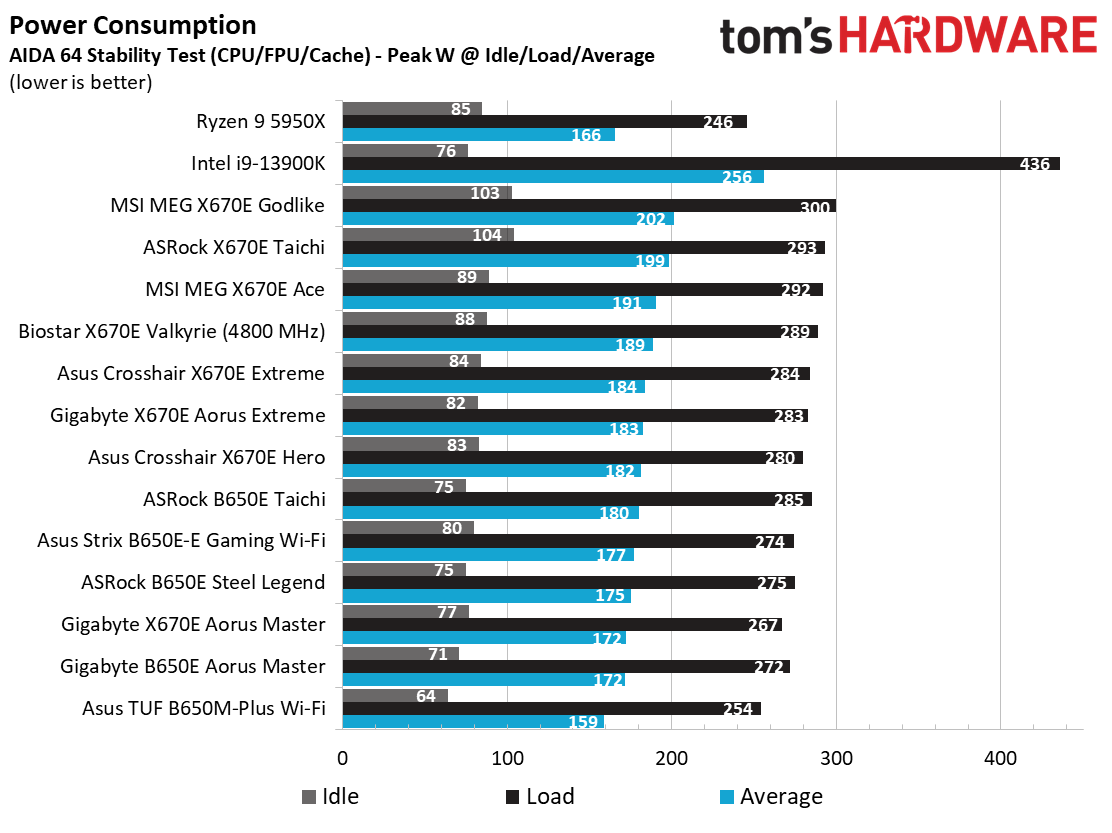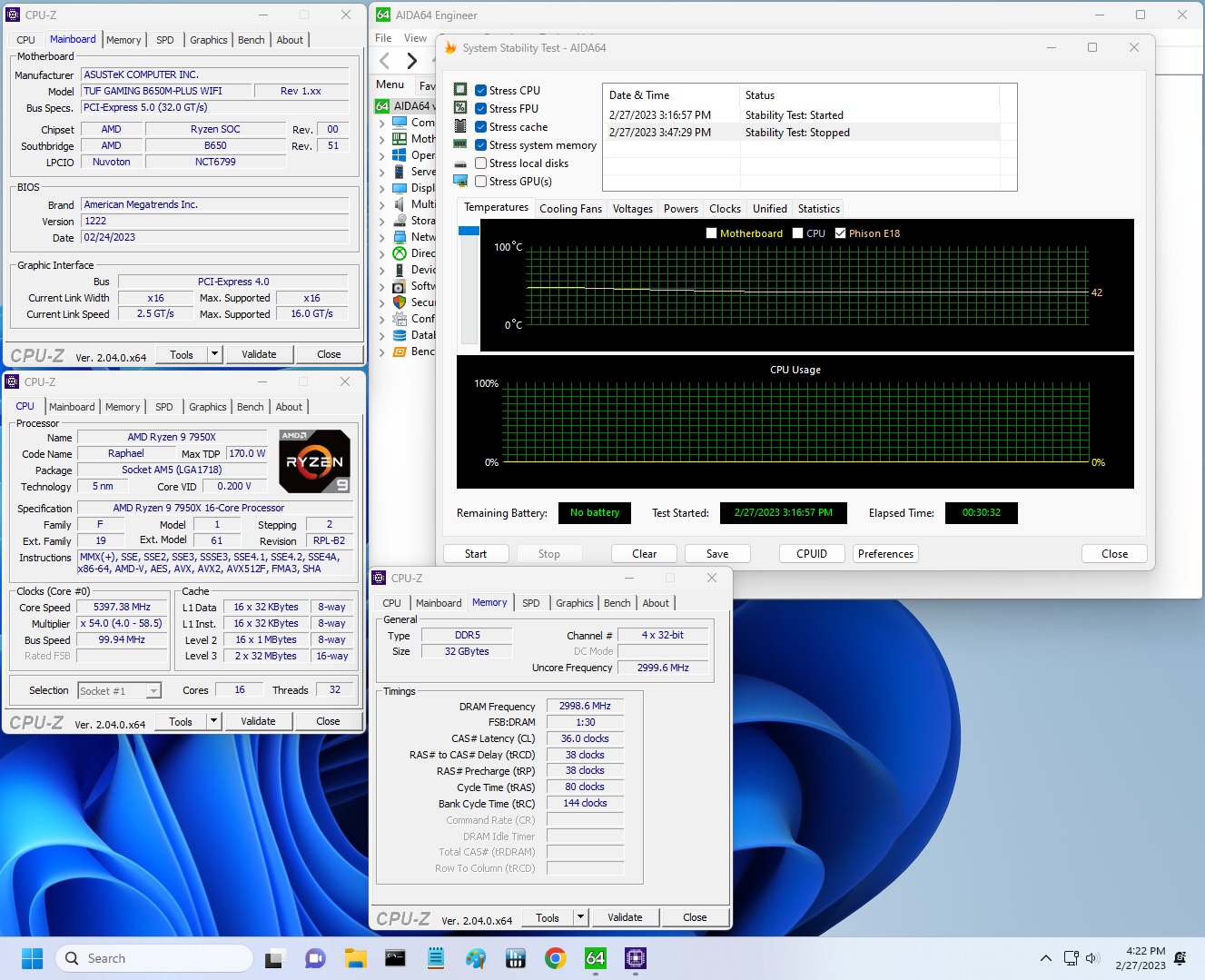Why you can trust Tom's Hardware
Benchmark Results
Our standard benchmarks and power tests are performed using the CPU’s stock frequencies (including any default boost/turbo), with all power-saving features enabled. We set optimized defaults in the BIOS and the memory by enabling the XMP profile. For this baseline testing, the Windows power scheme is set to Balanced (default) so the PC idles appropriately.
Synthetic Benchmarks
Synthetics provide a great way to determine how a board runs, as identical settings should produce similar performance results. Turbo boost wattage and advanced memory timings are places where motherboard makers can still optimize for either stability or performance, though, and those settings can impact some testing.
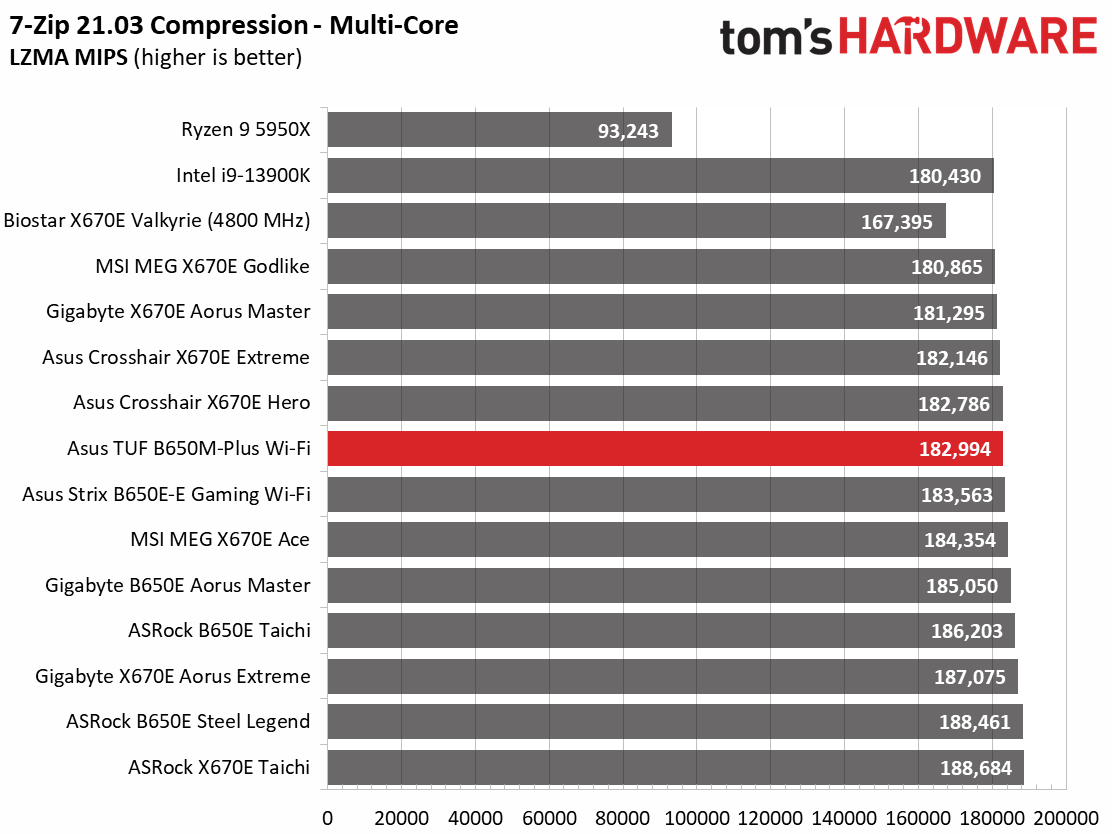
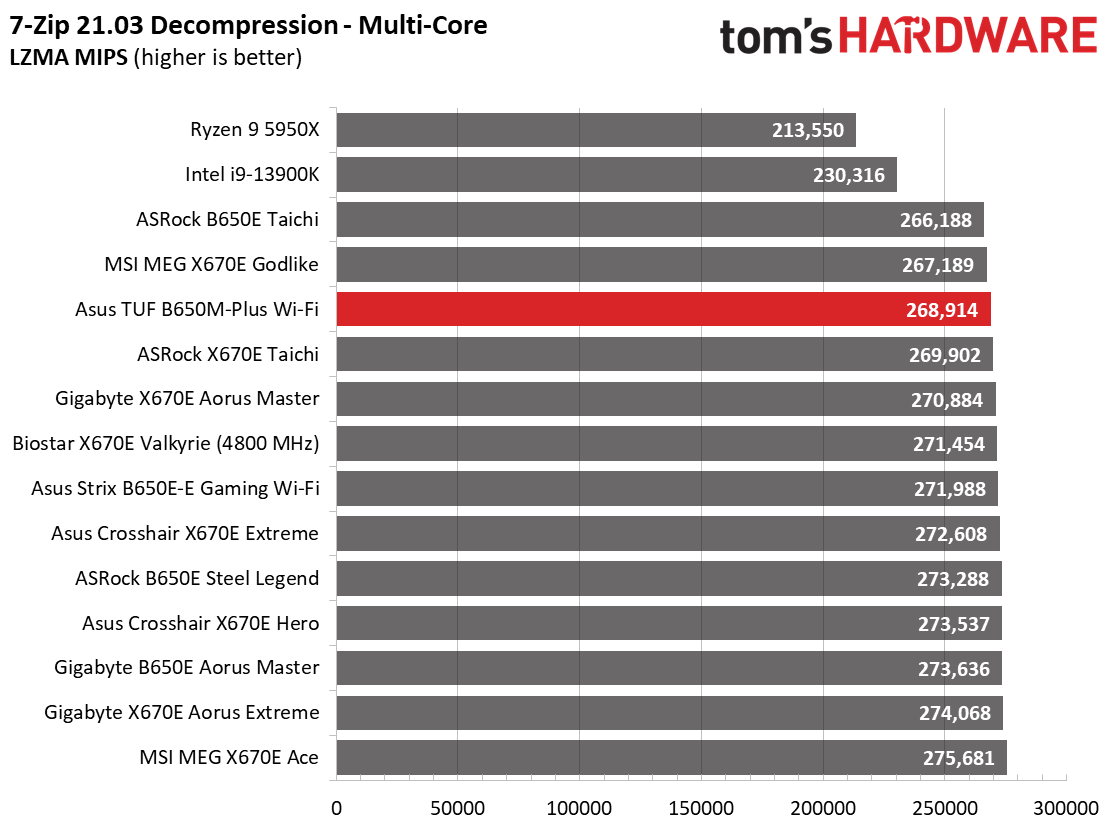
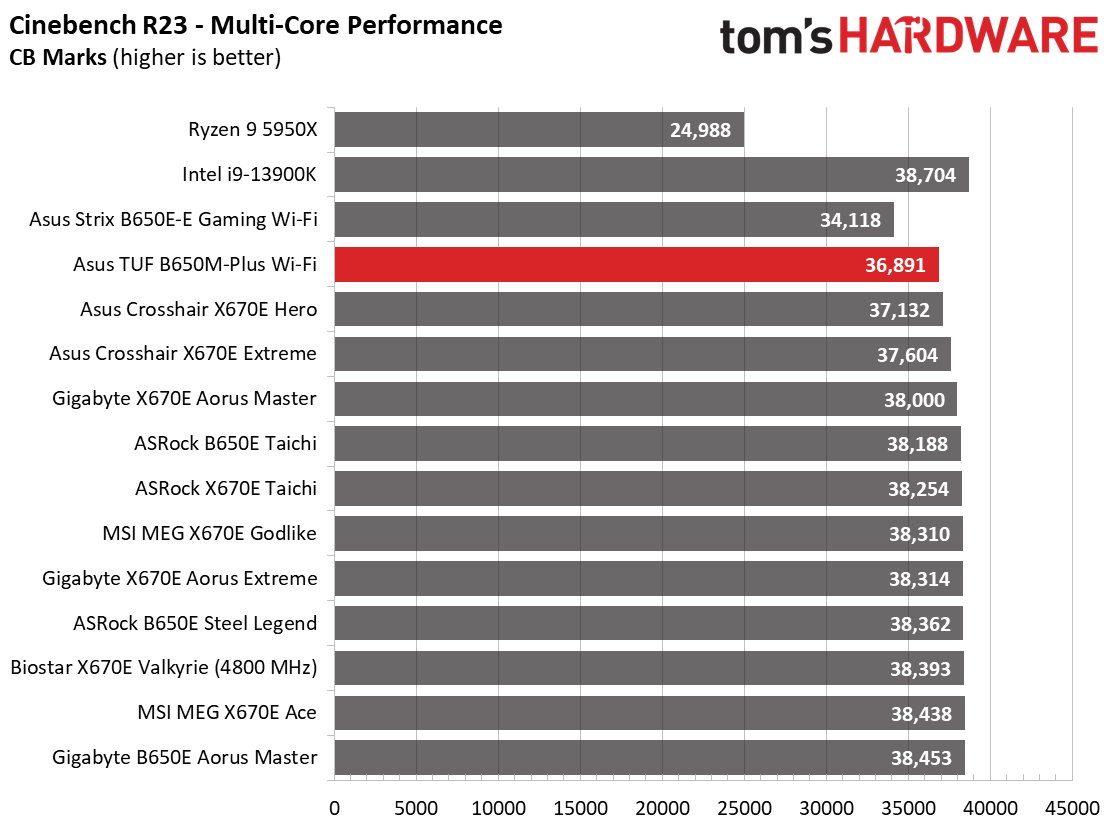
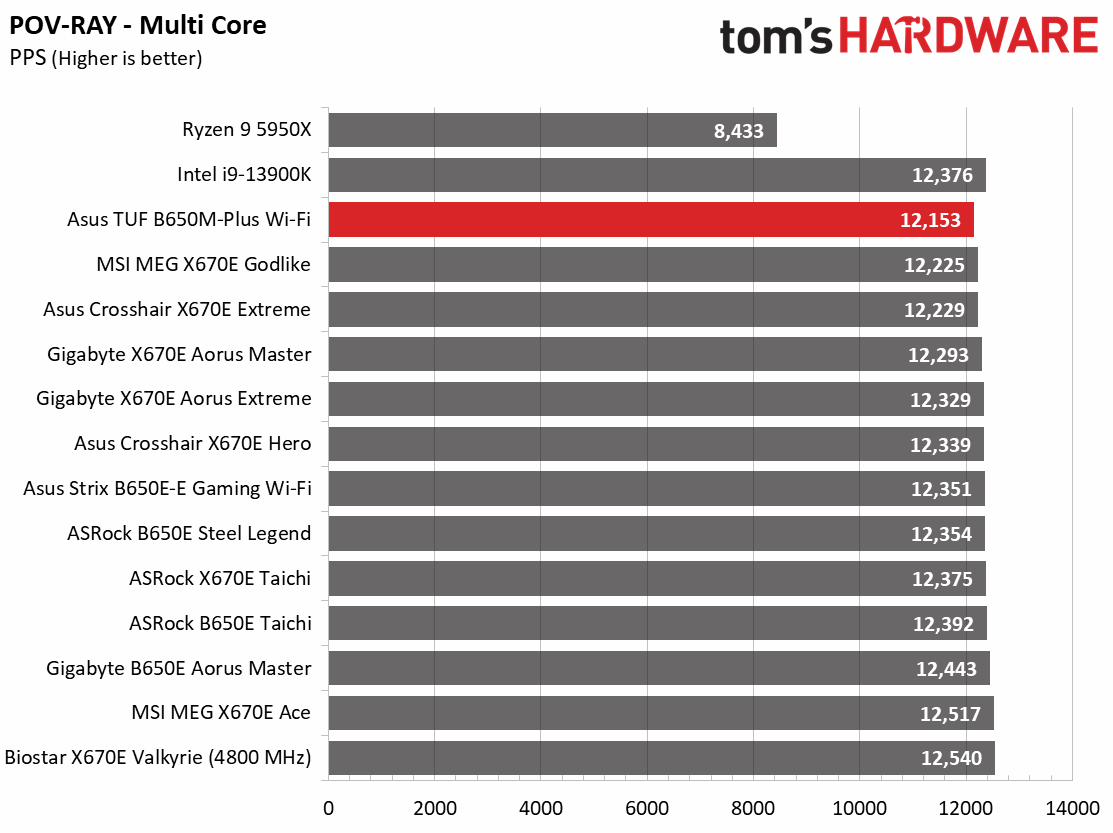

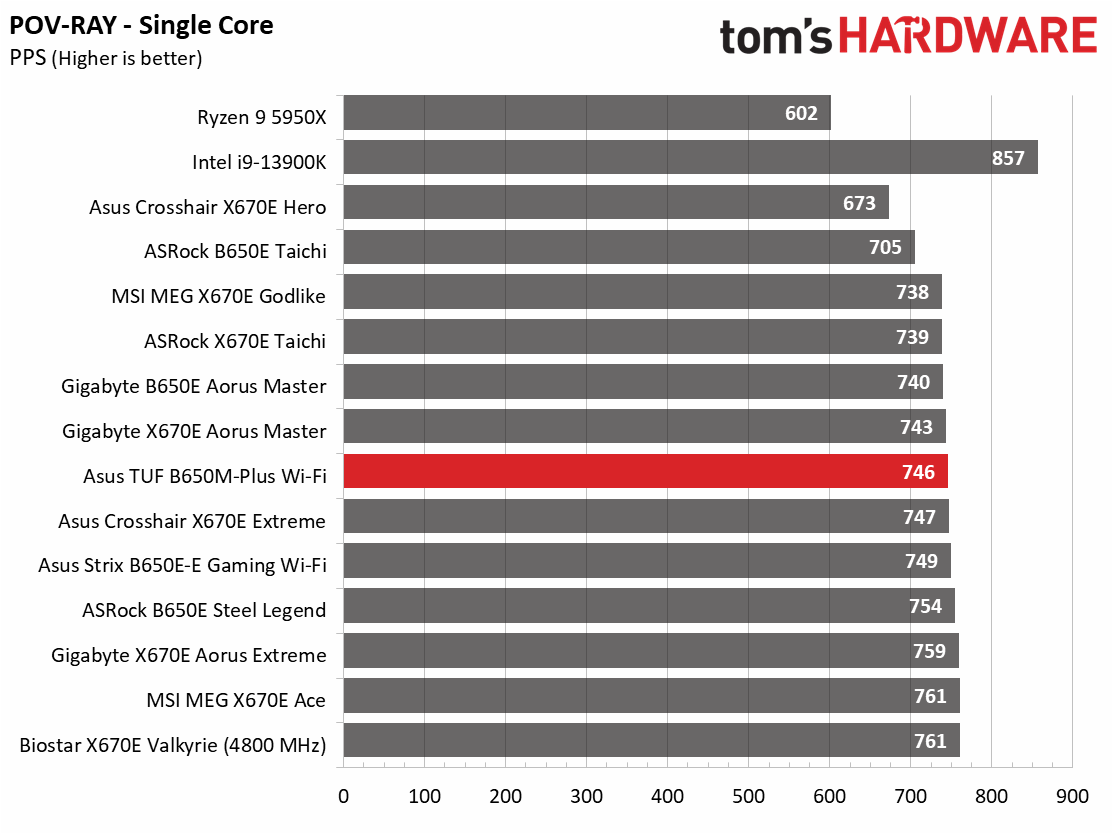
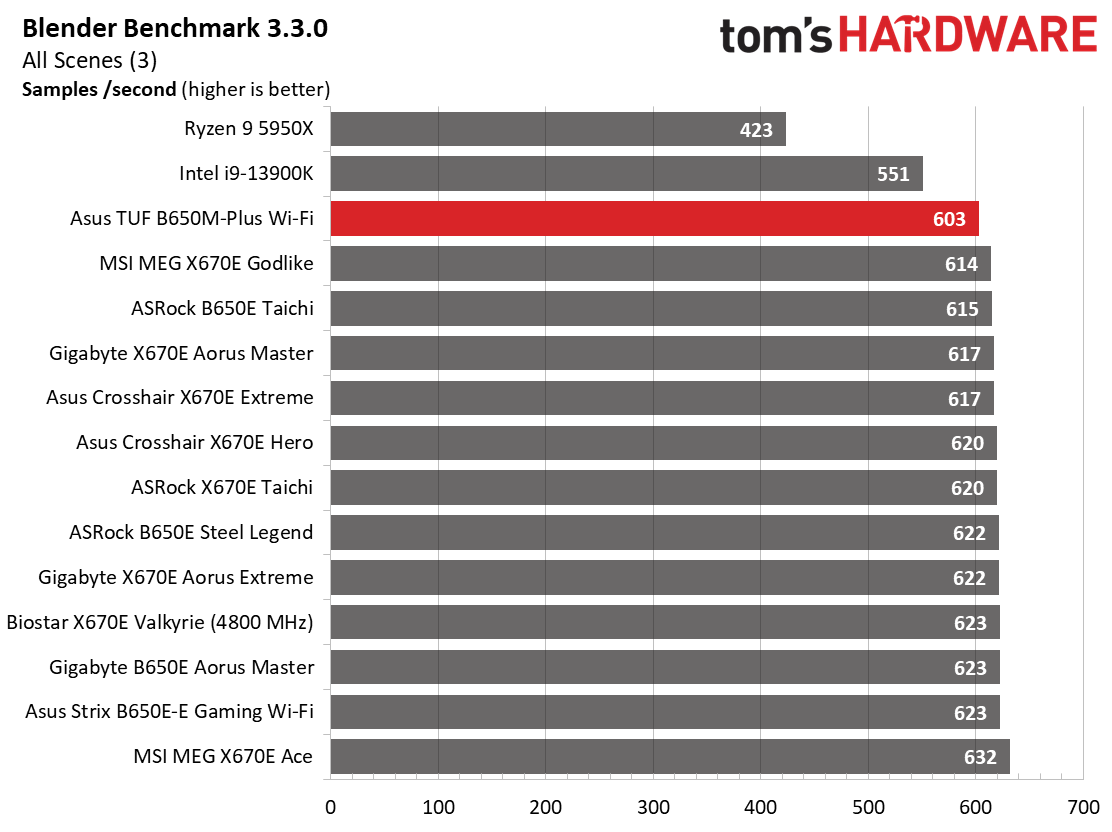
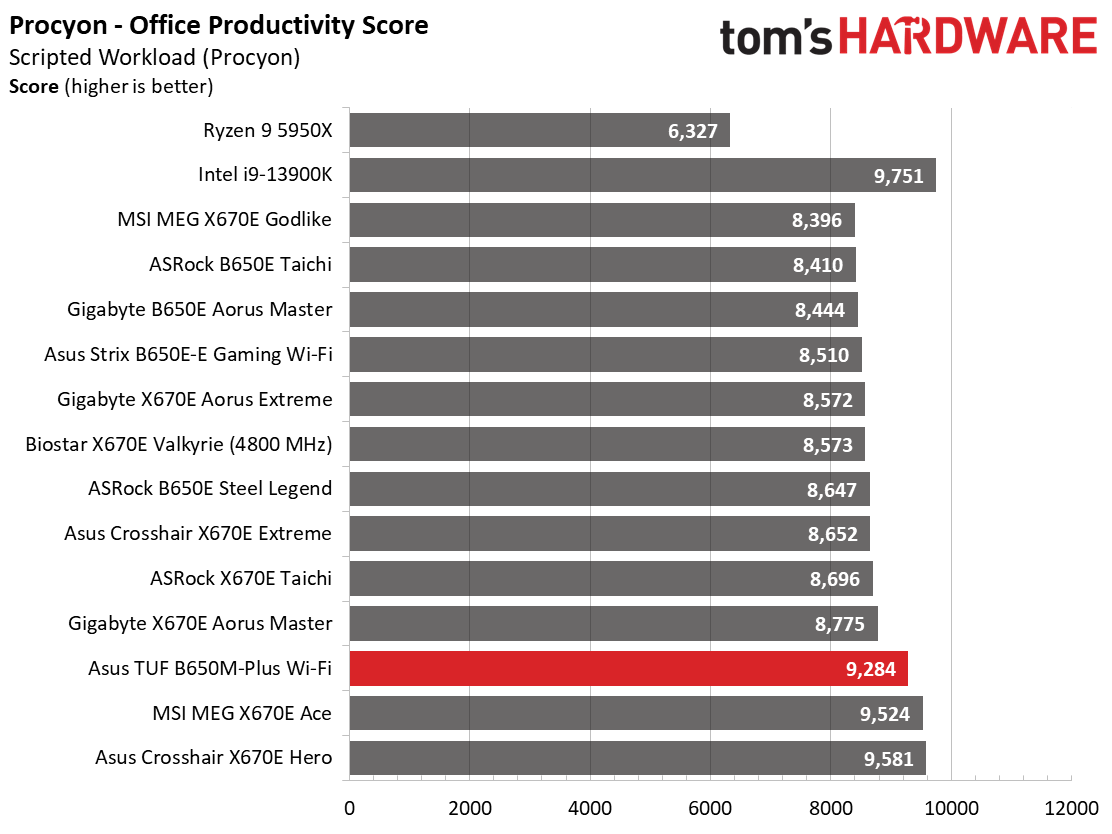
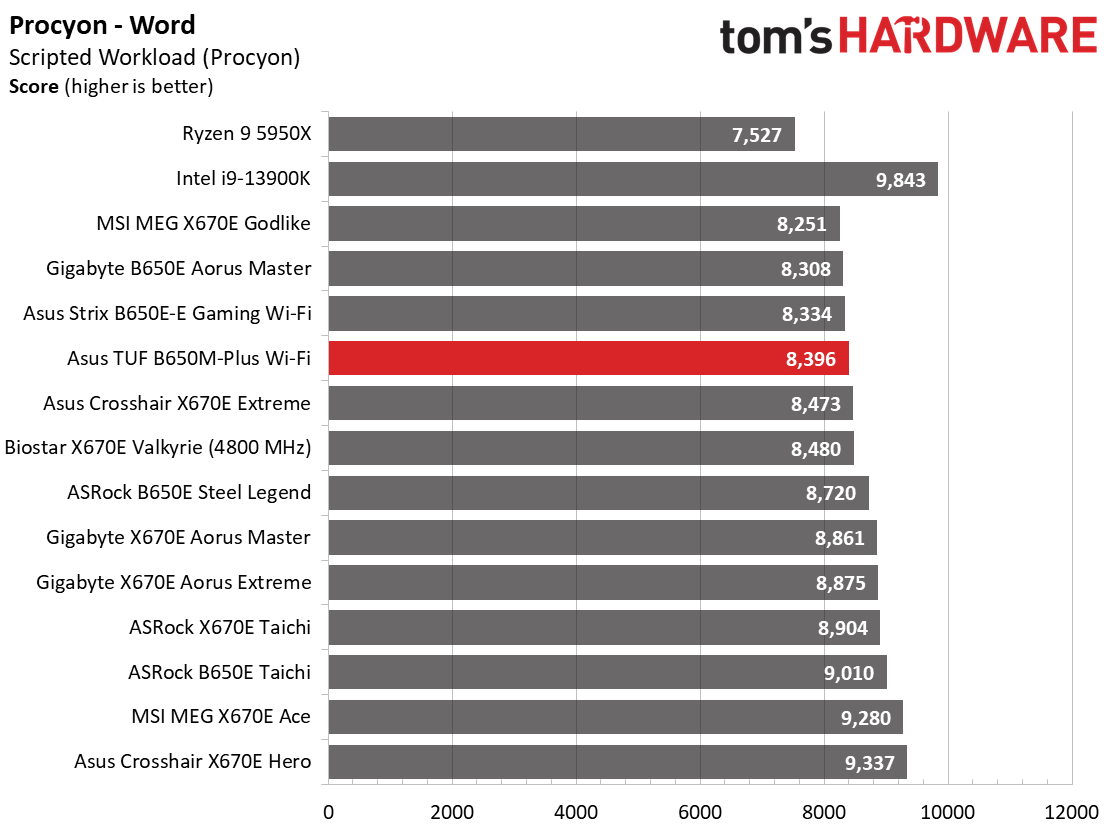
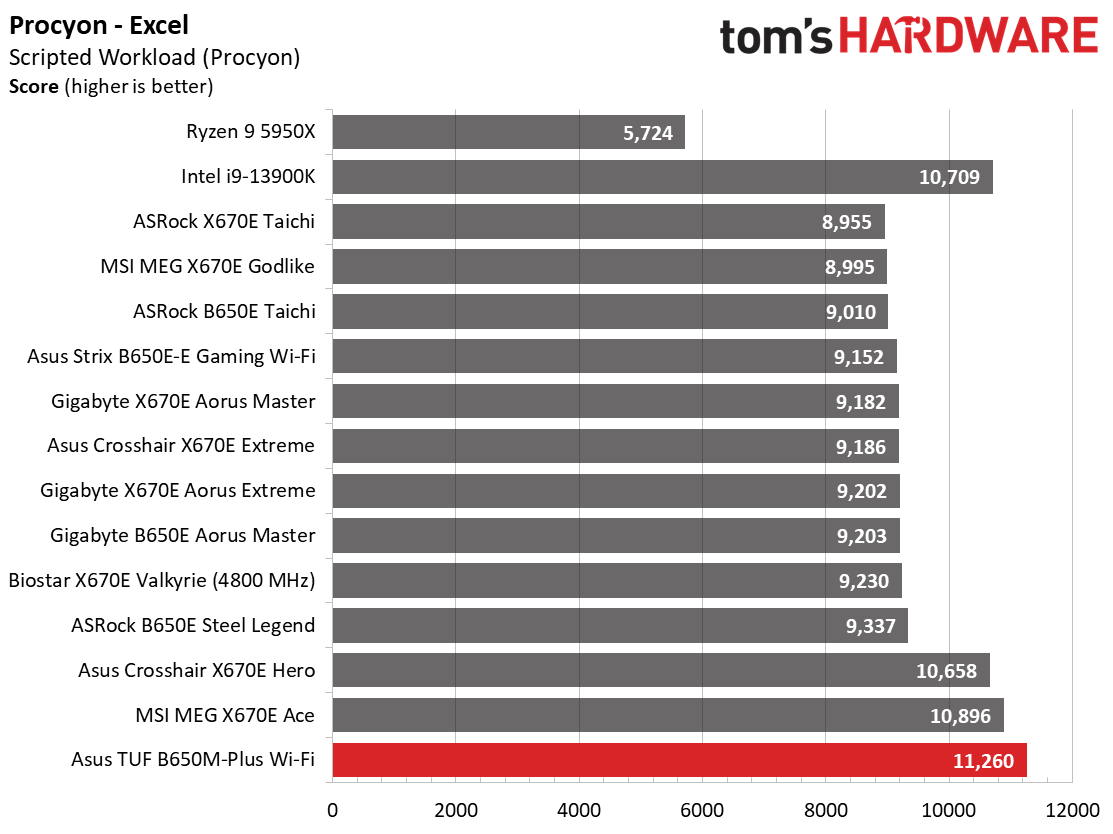
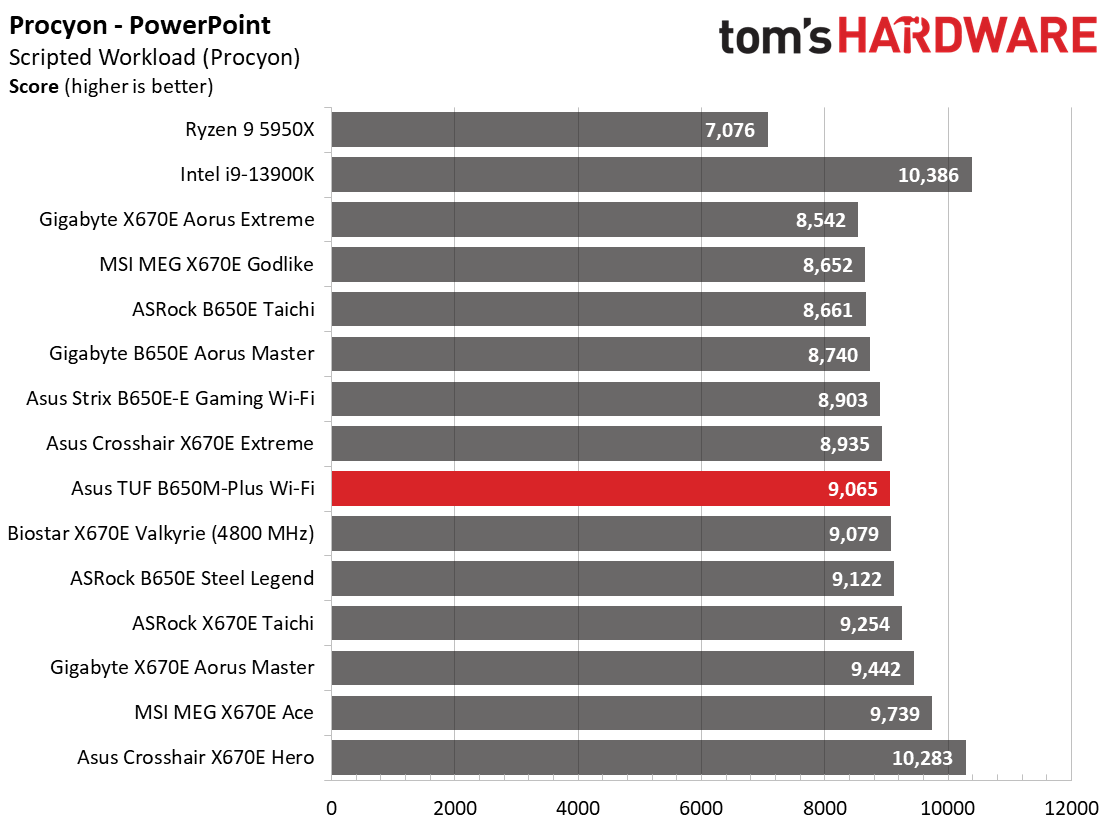
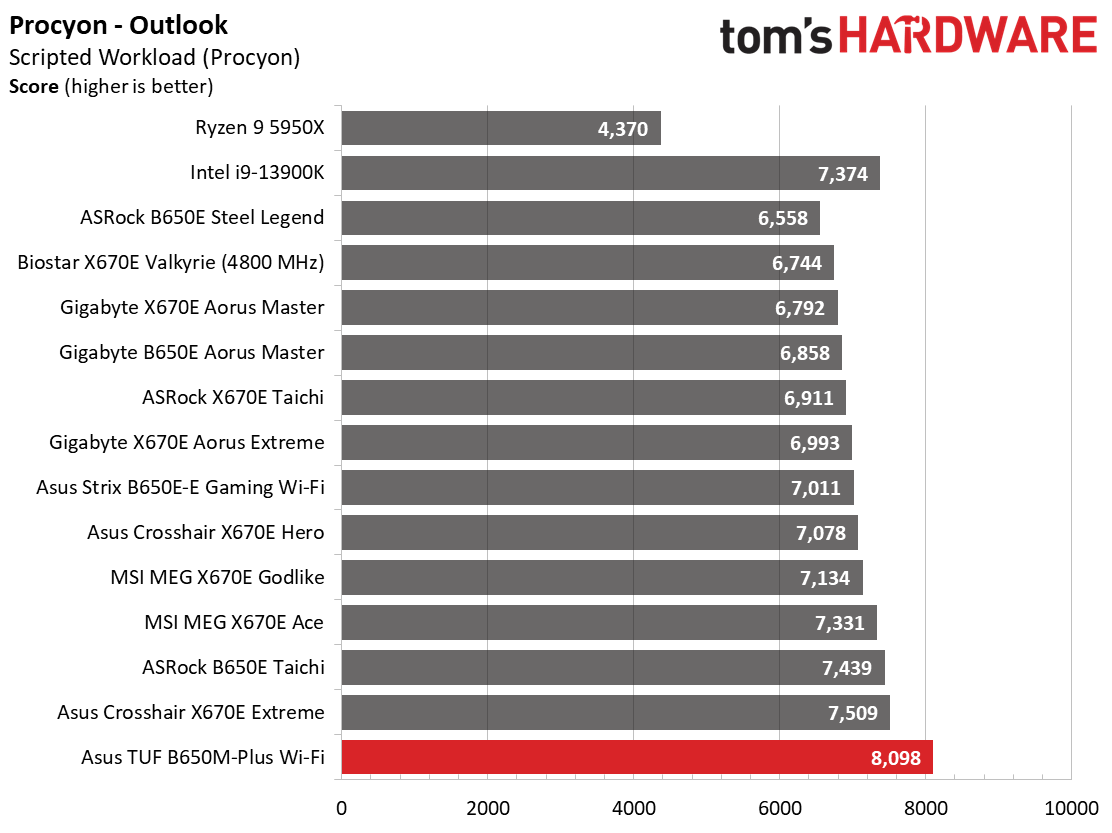
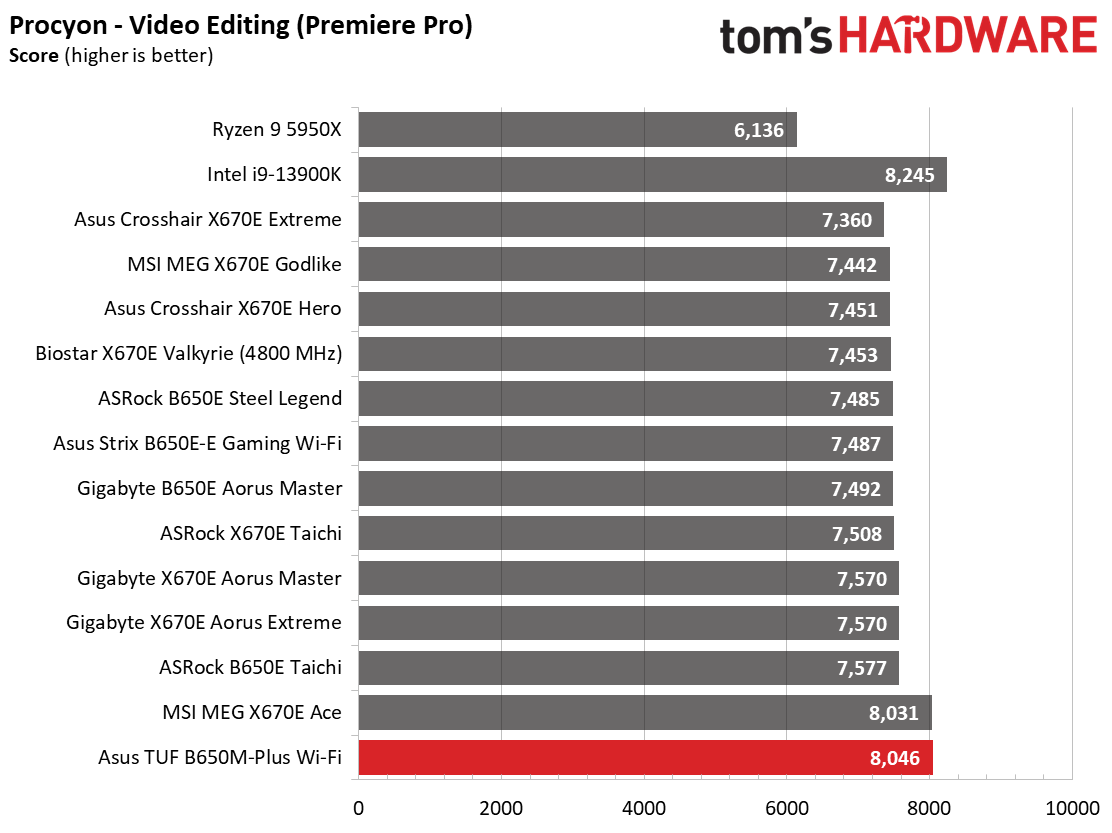
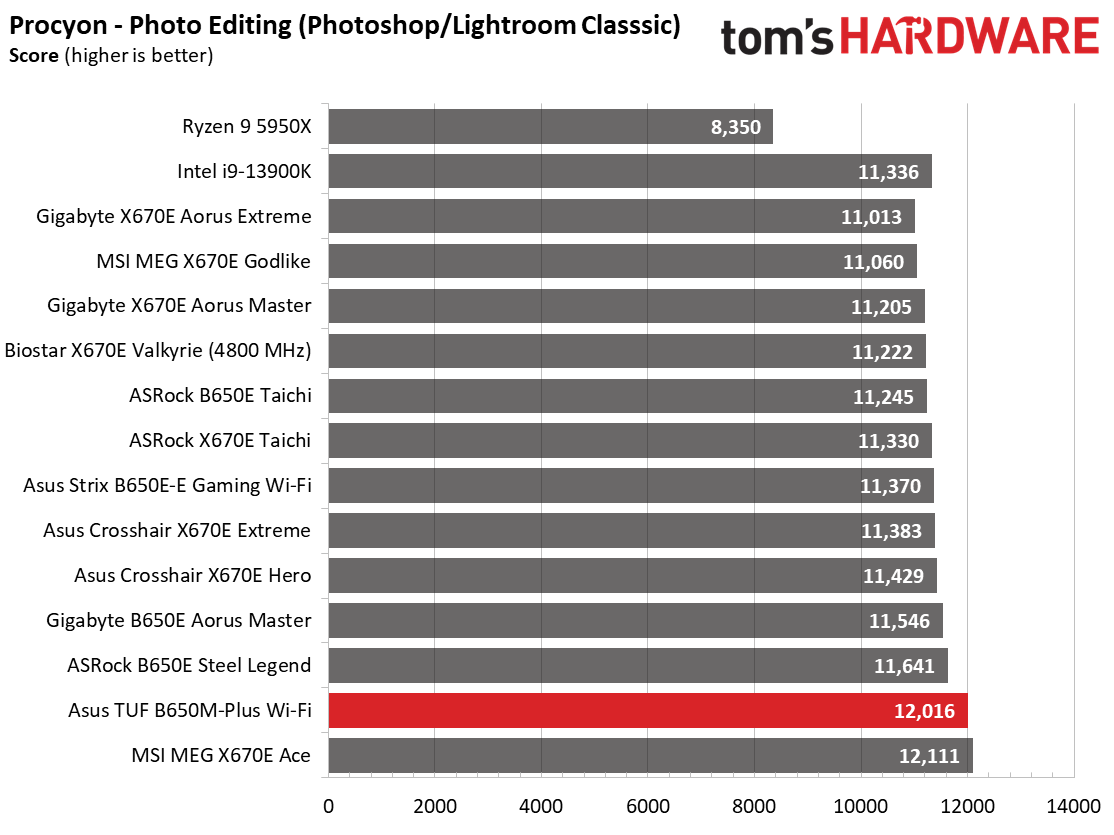
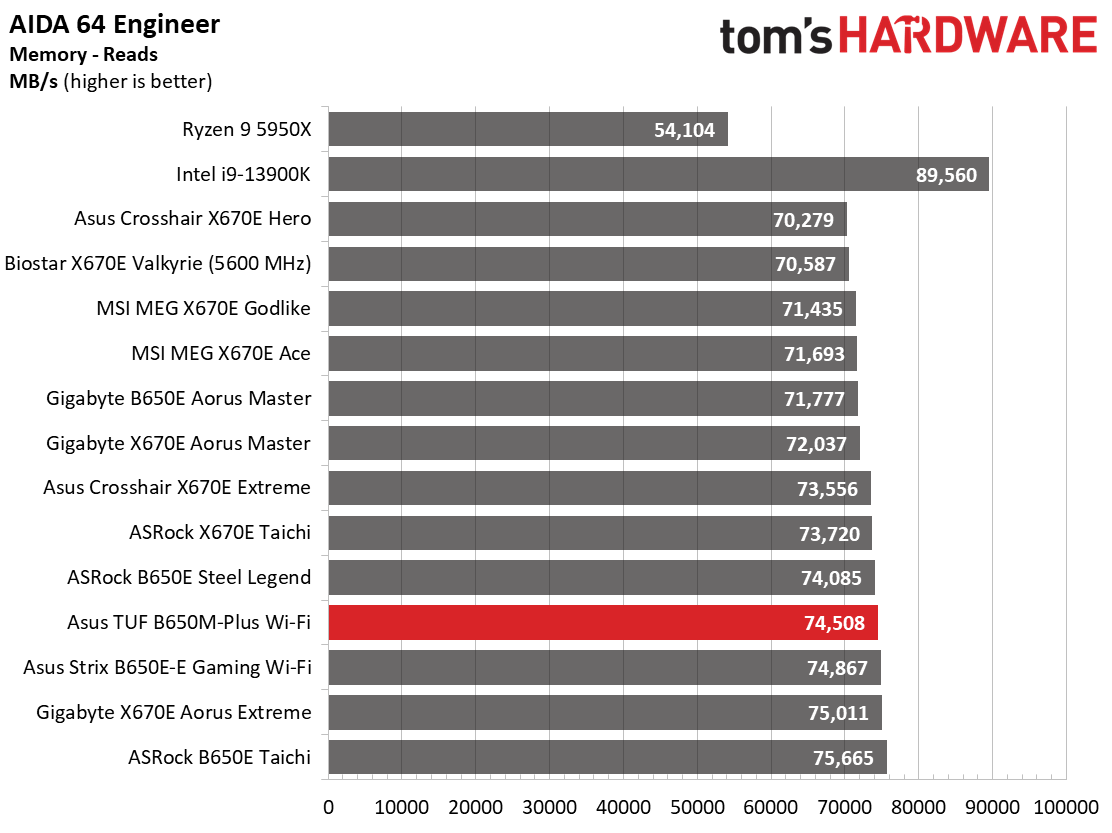
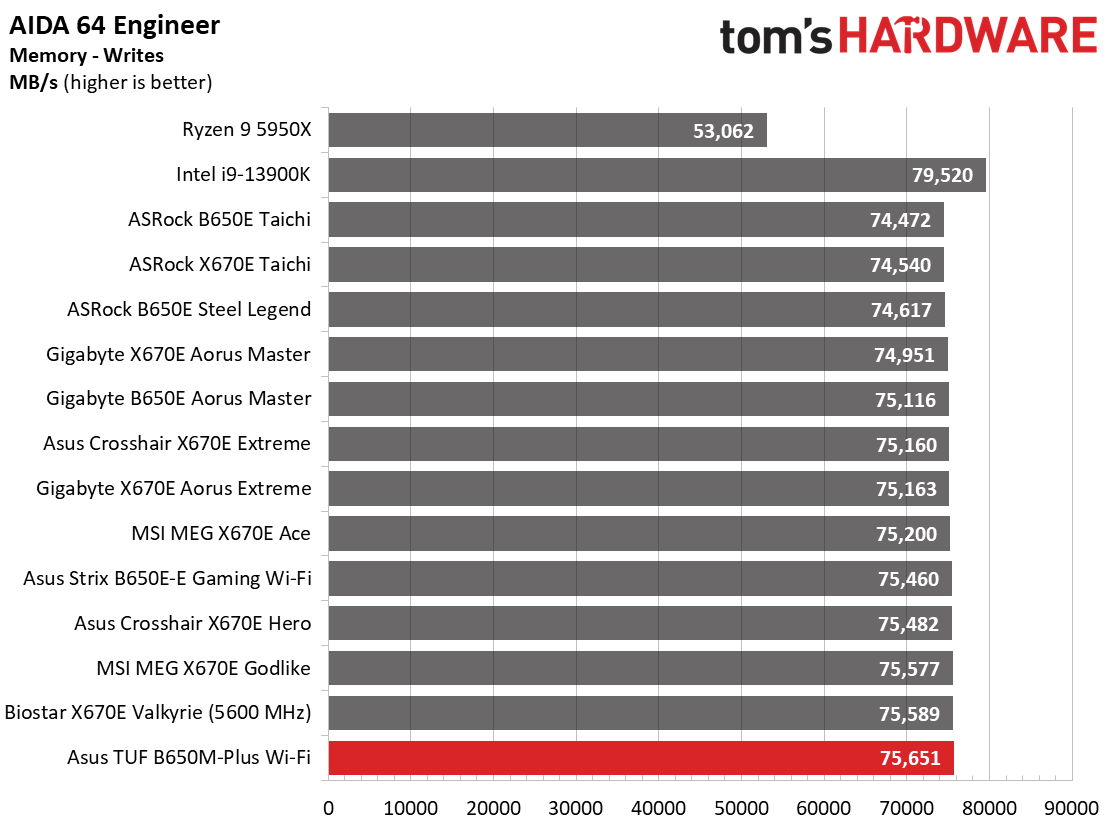
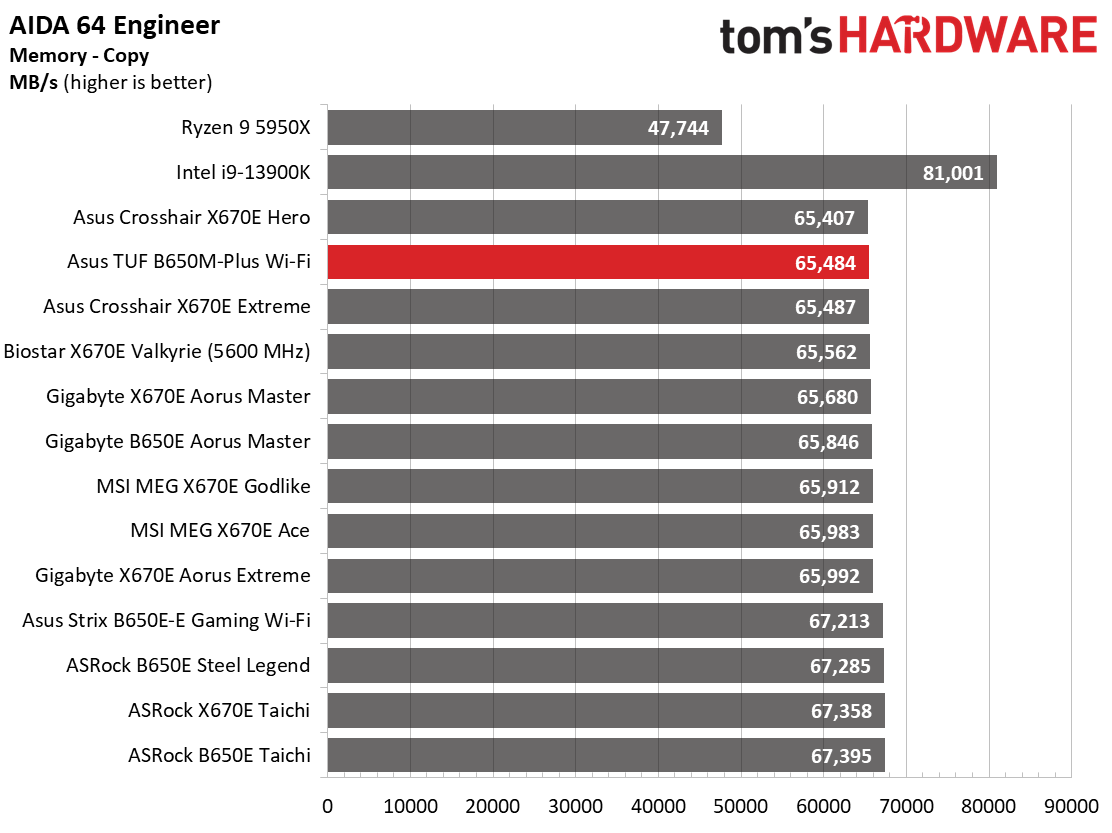
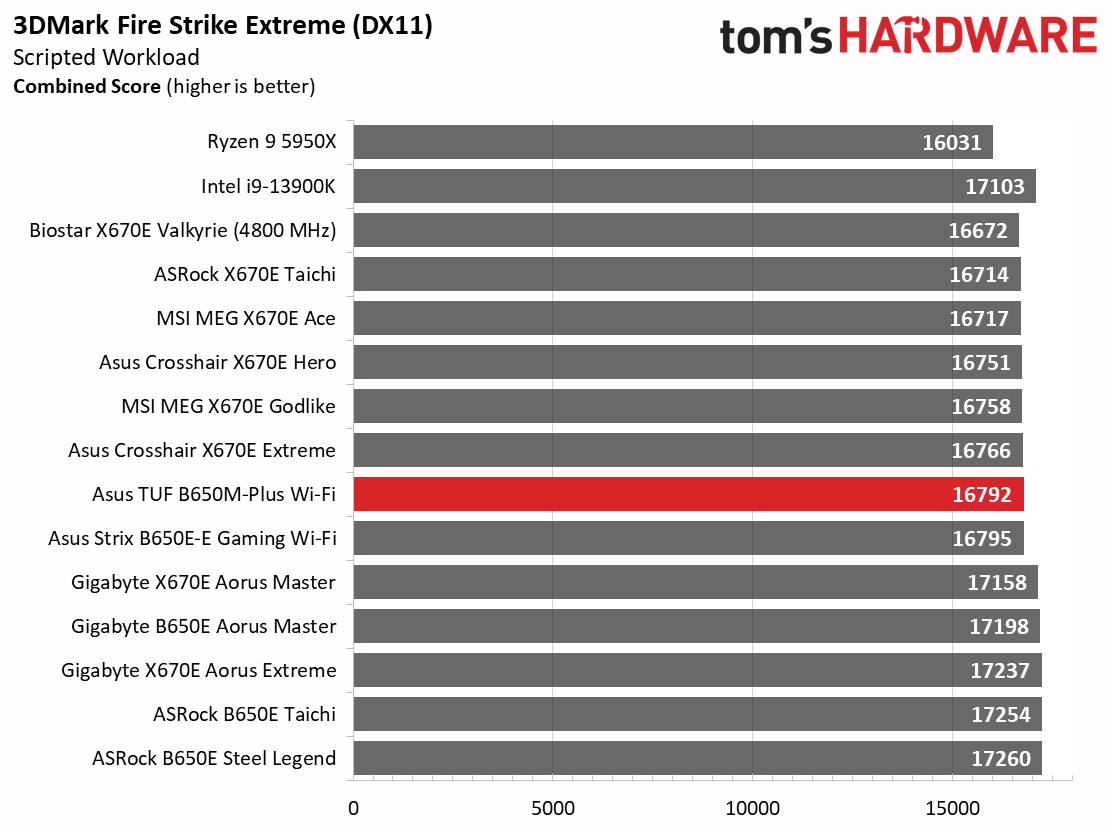
Results from our synthetic benchmarks show the Asus board is average to slightly below average in most tests. It did very well in the Procyon Office suite but struggled a bit with long-running and heavily multi-threaded loads compared to other boards. Generally, you won’t be able to tell the difference between this and the other review boards, which is what we expect.
Timed Applications
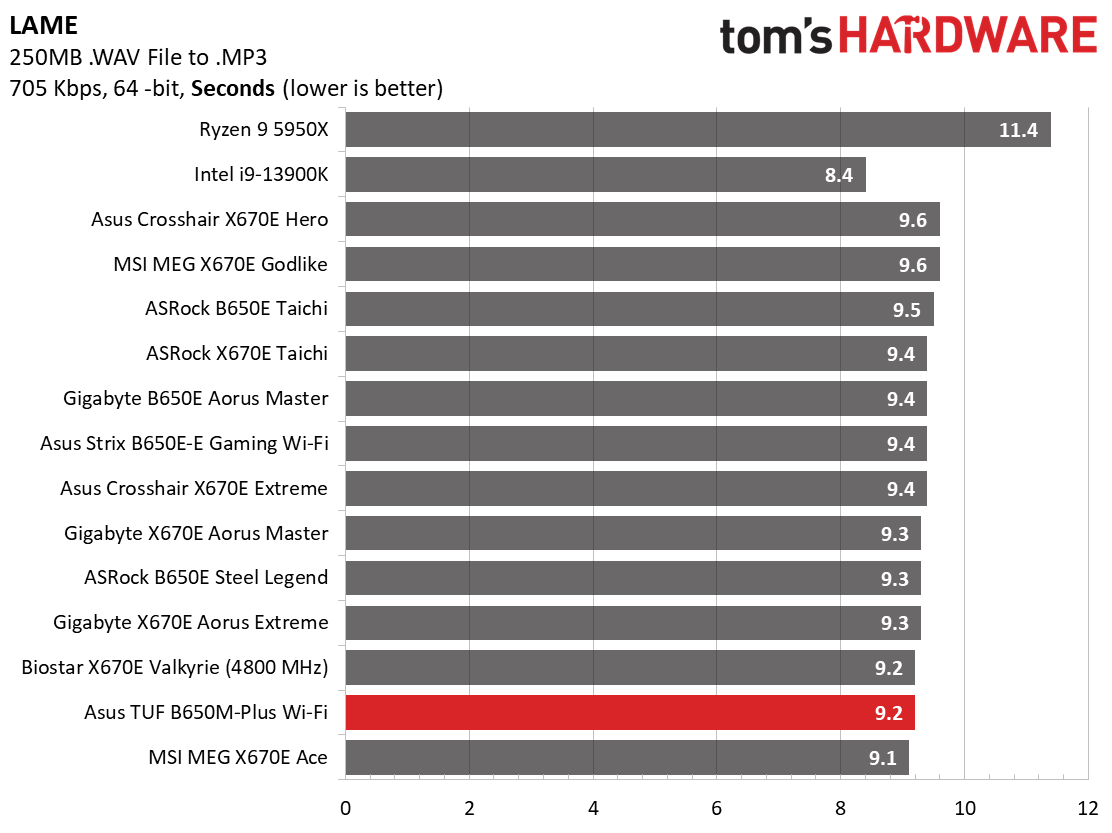
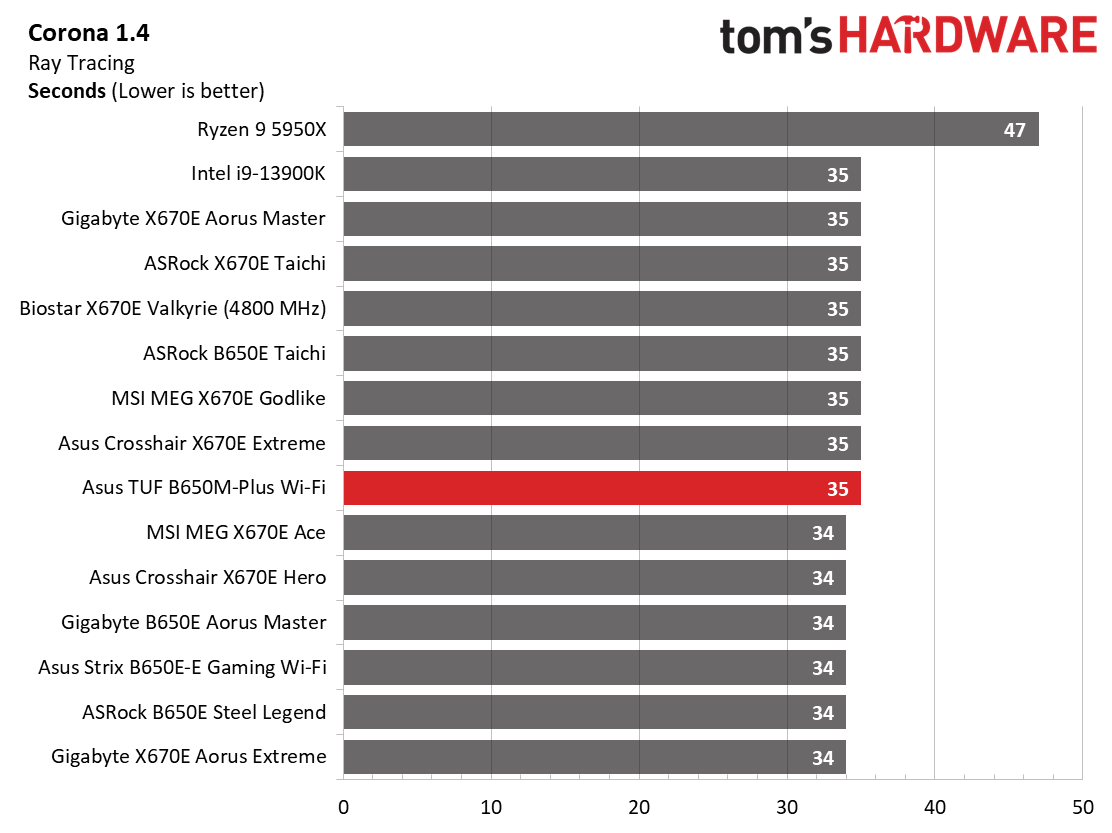
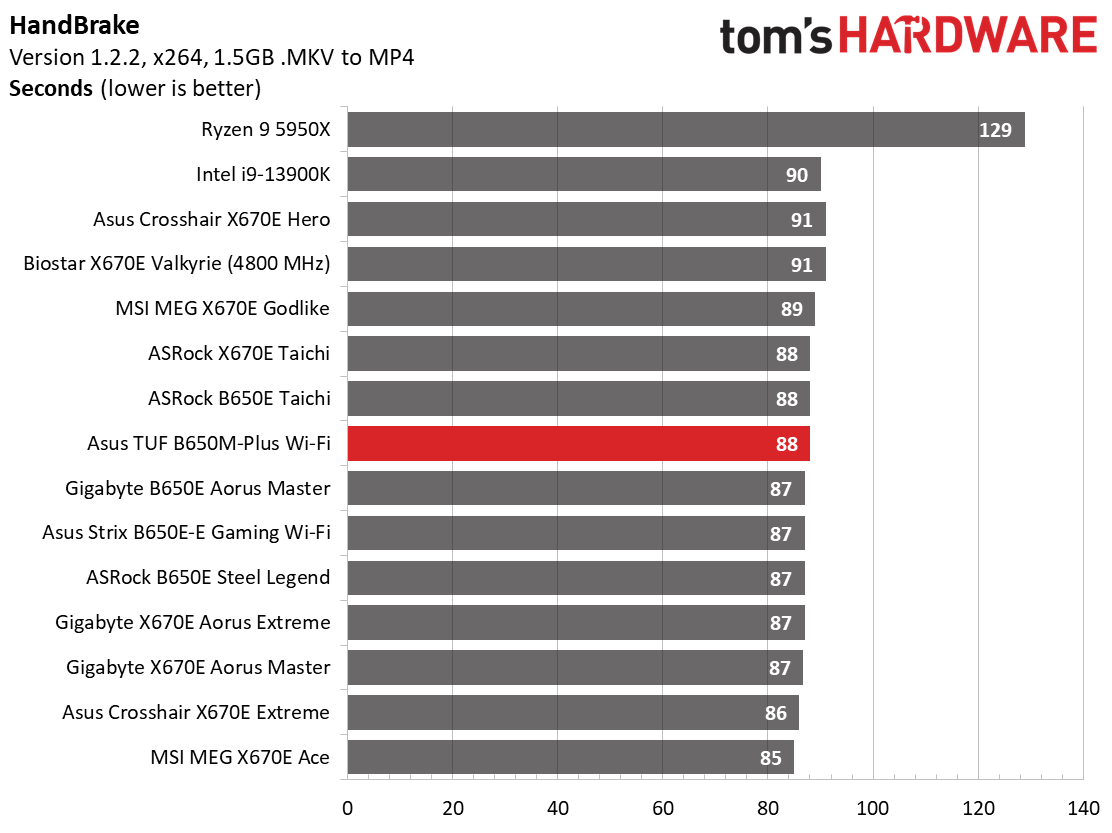
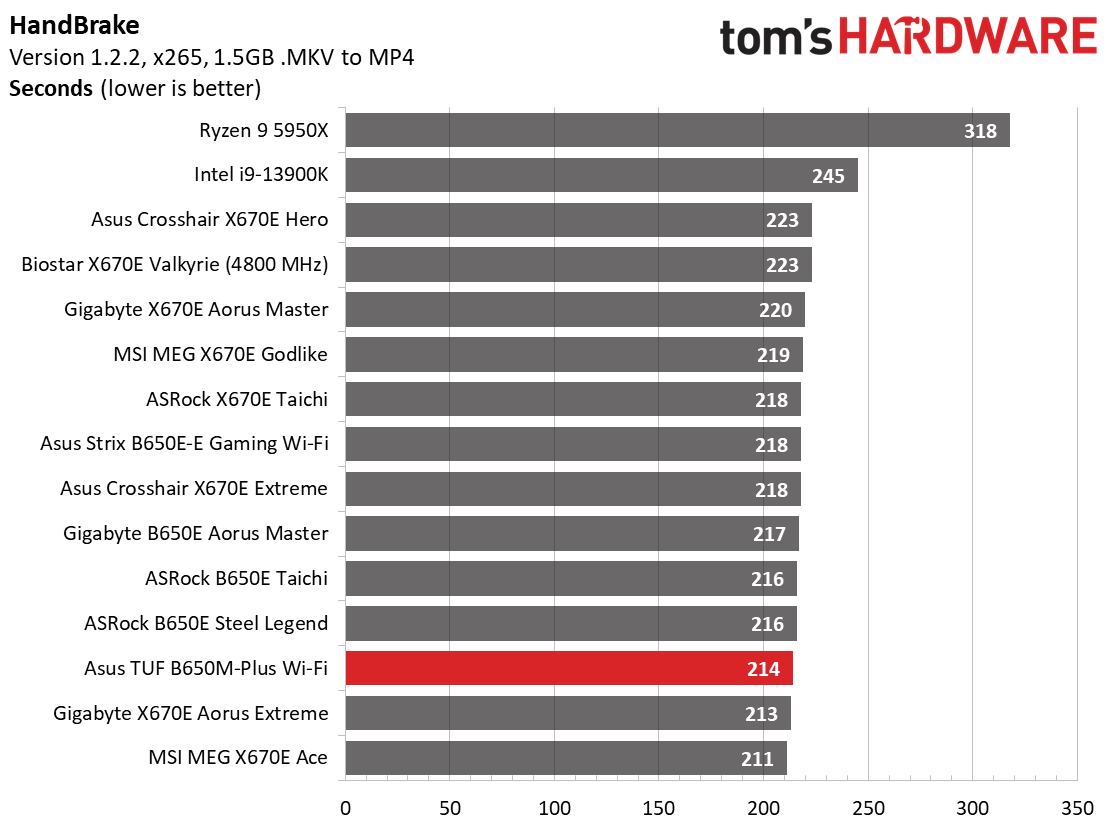
In the timed applications, the TUF B650M-Plus results were average to above average in Corona, LAME, and Handbrake benchmarks. There’s nothing to worry about here, either.
3D Games and 3DMark
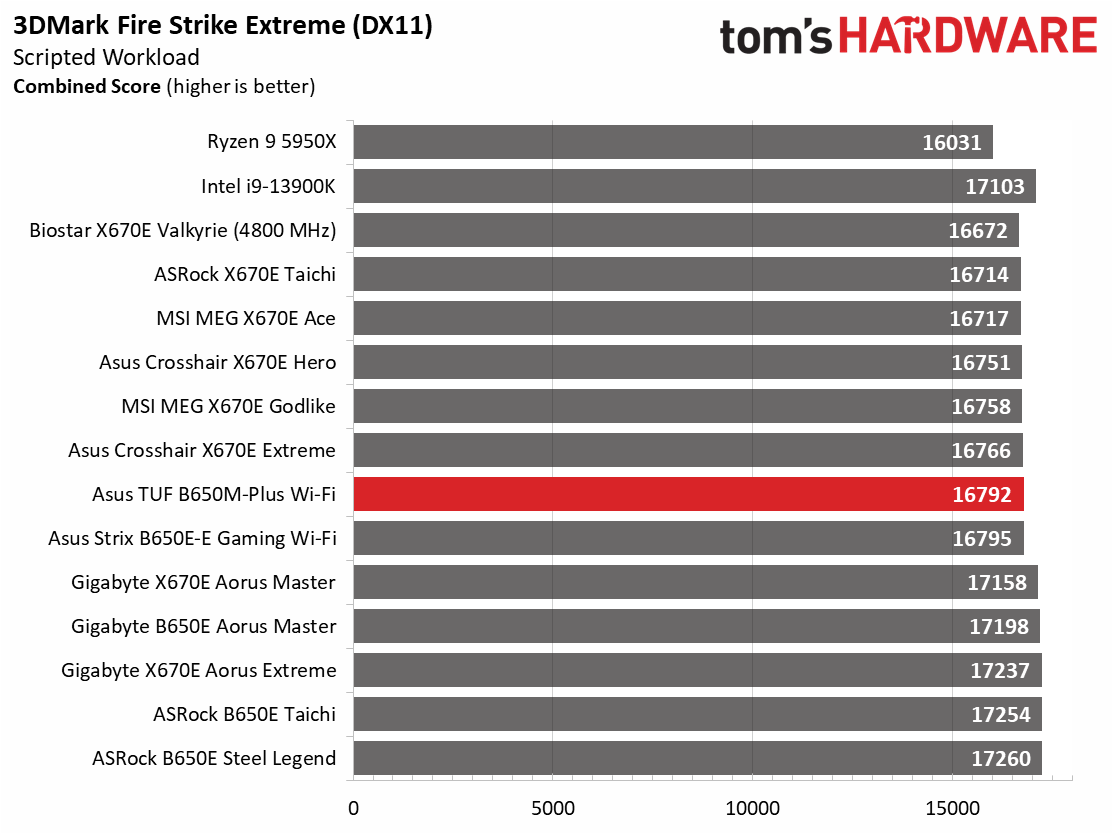
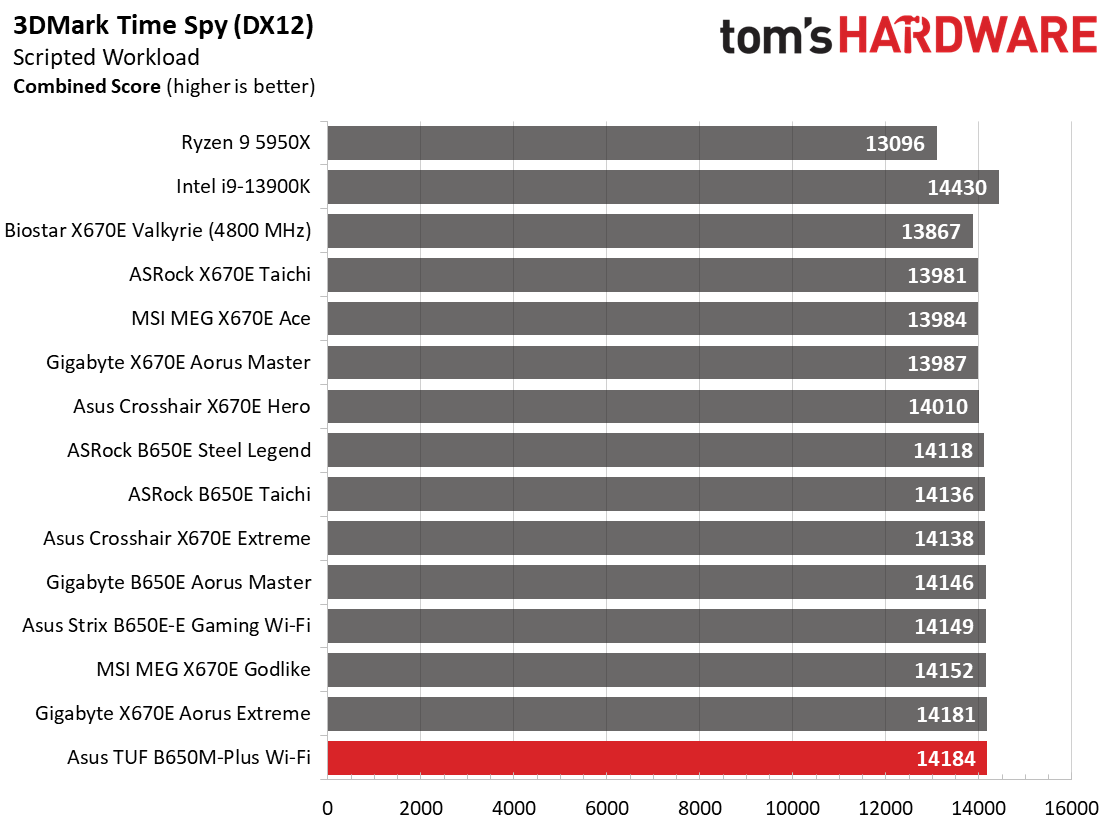
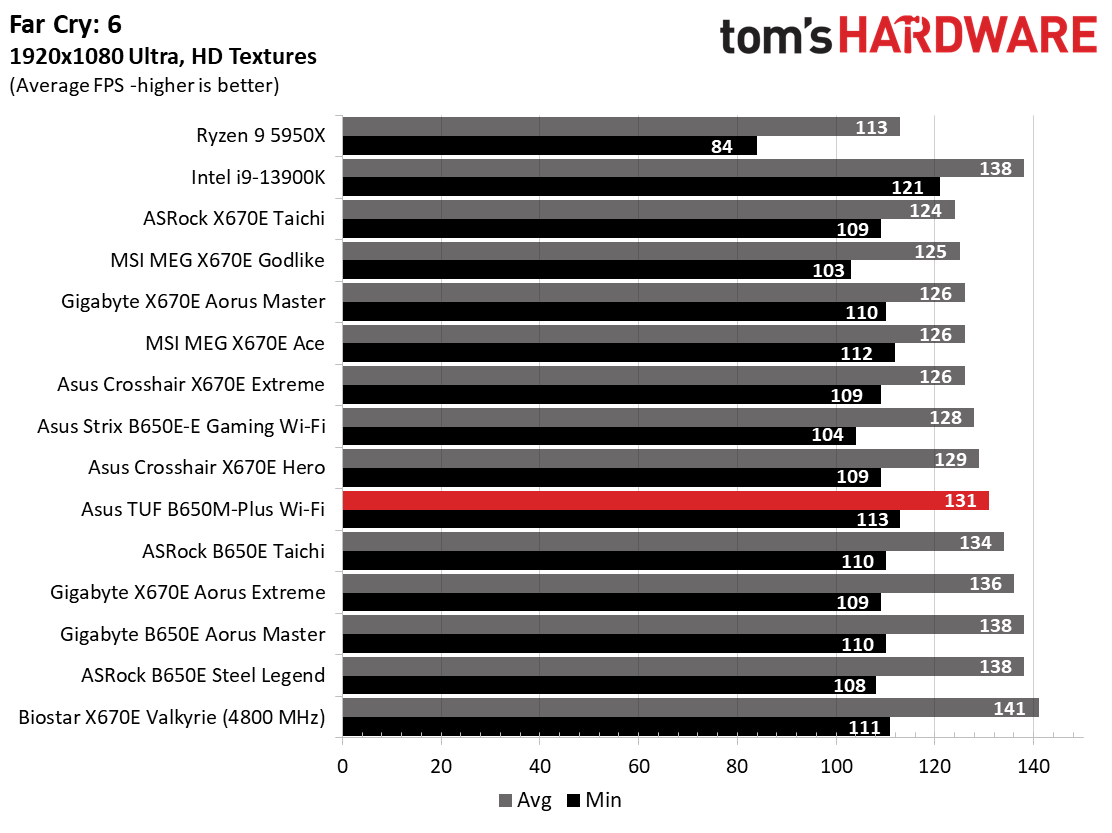
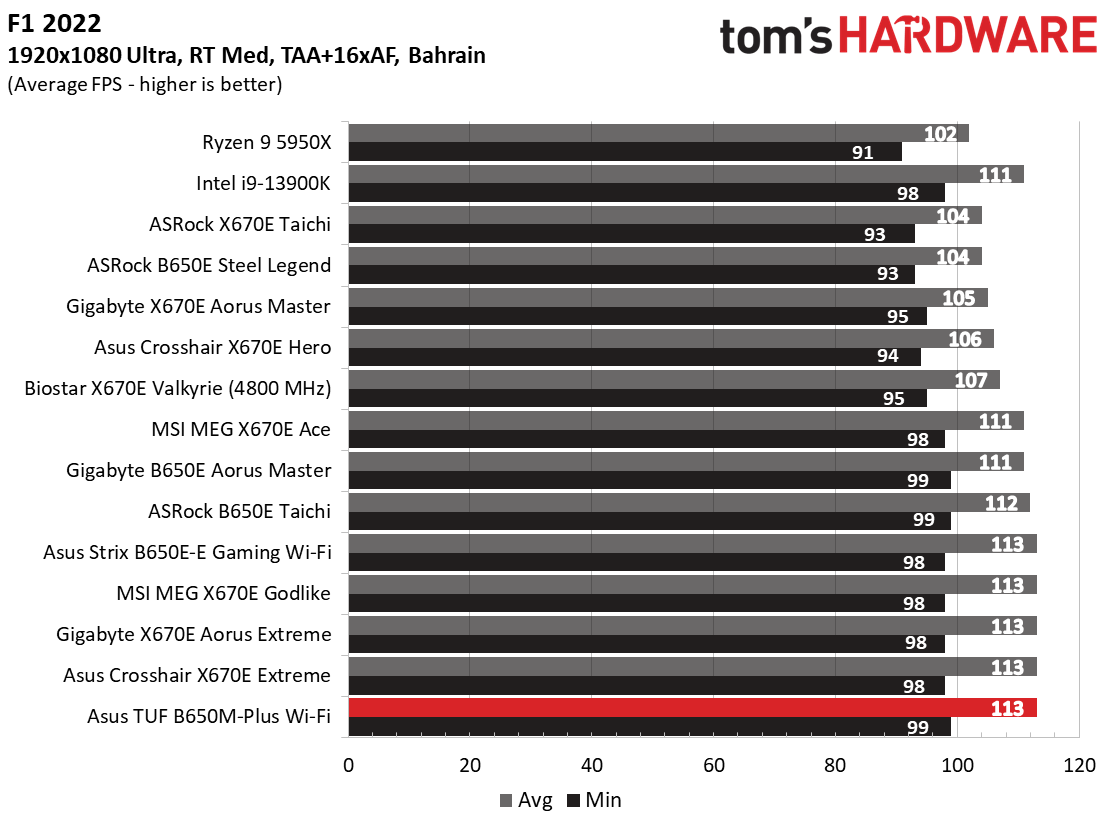
Starting with the launch of Ryzen 7000, we’ve updated one of our games, F1 21, to the latest version, F1 22. We're keeping Far Cry 6. We run the games at 1920 x 1080 resolution using the Ultra preset (details listed above). As the resolution goes up, the CPU tends to have less impact. The goal with these settings is to determine if there are differences in performance at the most commonly used (and CPU/system bound) resolution with settings most people use or strive for (Ultra). We expect the difference between boards in these tests to be minor, with most differences falling within the margin of error. We’ve also added a minimum FPS value, affecting your gameplay and immersion experience.
Our gaming tests showed the TUF Gaming a capable gaming board. Results across our benchmarks and games show the board matching or beating the others we’ve tested. This board will not cap your gaming experience.
Power Consumption / VRM Temperatures
We used AIDA64’s System Stability Test with Stress CPU, FPU, Cache and Memory enabled for power testing, using the peak power consumption value. The wattage reading is from the wall via a Kill-A-Watt meter to capture the entire PC (minus the monitor). The only variable that changes is the motherboard; all other parts remain the same.
Get Tom's Hardware's best news and in-depth reviews, straight to your inbox.
Power consumption for the Asus was the lowest we’ve seen across the board. At idle, it uses 64W, while under a stress test load, power consumption peaked at 254W. This averages out to 159W and is, by far, the least we’ve captured so far. If it’s efficiency you’re after, the default settings on this board yield the best power use we’ve seen so far.
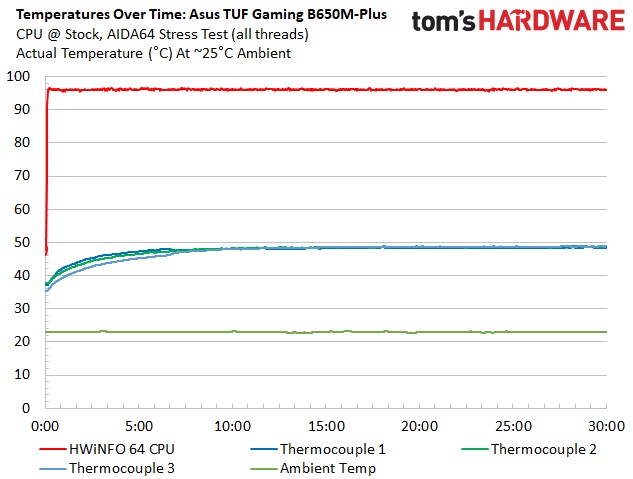
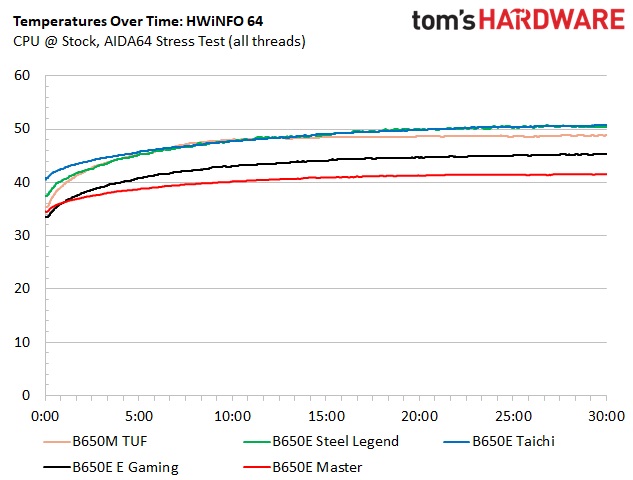
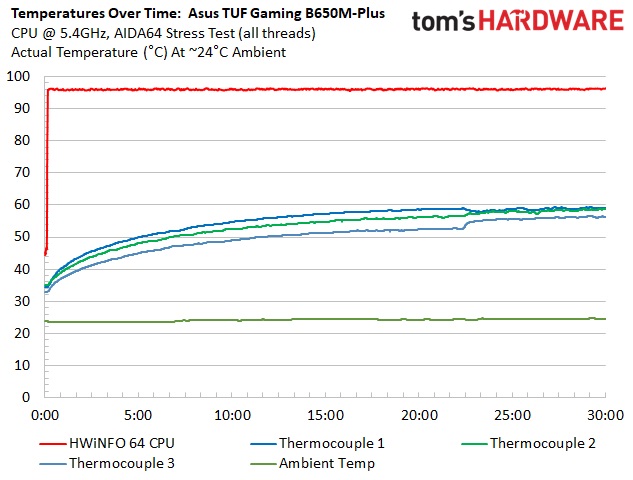

VRM temperatures on the TUF Gaming were well within specification during our testing. Among the (five) B650 boards tested, it was in the middle of all of them. The MOSFET’s comparatively meager 60A rating held up well with the oversized heatsinks, even with the 16-core 32-thread Ryzen 9 7950X strapped in the socket and overclocked.
Overclocking
Over the last few CPU generations, overclocking headroom has been shrinking (at least on the AMD side) while the out-of-box potential has increased. For overclockers, this means there’s less fun to have. For the average consumer, it means you’re getting the most out of the processor without manual tweaking. Our goal in this section is to increase the load on the VRMs and see if they can handle the additional stress. Overclocking AMD CPUs can be done in several ways (all-core or adjust PBO values). But for simplicity’s sake, we just went with an all-core overclock of 5.4 GHz with 1.30V to increase the power output.
Since our approach is to add power through all cores, we simply raised the CPU multiplier to 54x, manually set the voltage to 1.30V, and adjusted LLC to minimize vdroop. On the memory side, AMD states the sweet spot is around DDR5-6000, so we used the Kingston Fury kit, set the AMD EXPO profile and checked for stability.
After setting the CPU multiplier, Vcore and adjusting LLC to mitigate vdroop (there was plenty at default settings), we overclocked the system without concern. In our limited overclock testing (stress test), the board performed well.
On the memory side, we dropped in our Kingston Fury Beast DDR5-6000 kit, enabled EXPO and things were stable out of the gate. The board lists support for slightly higher speeds (to DDR5-6000), so presumably, there’s still some headroom available. Most boards top out around DDR4-6400/6600, anyway.
Bottom Line
Asus’ TUF Gaming B650M-Plus Wi-Fi is a well-equipped solution in the budget-focused B650 space, with two M.2 sockets (one PCIe 5.0), four SATA ports, capable power delivery, and the TUF style and reliability, thanks to military standard testing. Asus tests the LANGuard, capacitors and chokes to meet MIL-STD-202/G regulations. I’m not sure how much that is worth in your presumably climate-controlled environment, but it’s good to know the board can handle extremes.
There’s plenty of competition for this board, as each company has a Micro ATX option around this price range. The ASRock B650M PG Riptide Wi-Fi ($189.99) is the least expensive of the bunch. MSI’s Pro B650M-A Wi-Fi and the Gigabyte B650M Aorus Elite AX are $199.99, with the Asus TUF Gaming being the most expensive at $229.99. Hardware-wise, there aren’t a lot of differences between these models; they all sacrifice something on this platform to keep the costs low. Power delivery is ‘good enough’ on all of them, with remarkably similar storage port counts/types, except for our TUF board sporting a 20 Gbps USB port, which the others lack.
All these boards are adequate budget solutions to build your new AM5 system around. But there isn’t really a stand-out option unless you like the looks of one in particular. I personally prefer the look of the Gigabyte over the rest, and it (like the ASRock) includes integrated RGBs as well. But hardware-wise, it’s tough to discern. If you’re looking for an inexpensive way into the AM5 platform and want a 20 GBps Type-C port, the TUF Gaming B650M-Plus Wi-Fi is a valid option. If a 20 Gbps USB port isn’t a requirement, less expensive options with otherwise very similar features are available.
MORE: Best Motherboards
MORE: How To Choose A Motherboard
MORE: All Motherboard Content

Joe Shields is a staff writer at Tom’s Hardware. He reviews motherboards and PC components.
-
Elusive Ruse The Asus premium is real, you can get a B650M Aorus Elite AX for $180 hell you can get the Elite ATX form factor for $209.Reply -
bitbucket The review said the the rear panel "only" had seven type-A ports. Just out of curiosity how many are most people using? Currently I'm only using one, for a dongle that communicates with my keyboard/trackball. Would anyone like to comment on how many rear USB ports are in use and for what purposes?Reply -
Elusive Ruse Reply
2x external SSDs, Vdrums module, audio interface, mouse, keyboard, USB headset, webcam, Wacom tablet. My current MOBO doesn't have enough to support everything so I'd def go for as many ports as I can get for my next build.bitbucket said:The review said the the rear panel "only" had seven type-A ports. Just out of curiosity how many are most people using? Currently I'm only using one, for a dongle that communicates with my keyboard/trackball. Would anyone like to comment on how many rear USB ports are in use and for what purposes? -
Ogotai Reply
and what is your price definition of mid range then ? $100 ?????PlaneInTheSky said:$230 for a midrange board.
